ATMC ICT310 System Analysis and Design Project - Semester 2, 2019
VerifiedAdded on 2022/11/02
|16
|2606
|210
Project
AI Summary
This document presents a System Analysis and Design project for the ICT310 course at ATMC. It explores the Software Development Life Cycle (SDLC), detailing its core processes such as planning, analysis, design, development, testing, and maintenance. The project also examines the Agile approach to developing Information Systems (IS), highlighting its principles and advantages in handling change and uncertainty. Part B focuses on modeling and diagramming, including a Use Case Model with an event table and a Use Case diagram describing the controller process, as well as a Domain Model Class Diagram and a Design Class Diagram. The project provides detailed explanations, diagrams, and a bibliography of relevant sources.
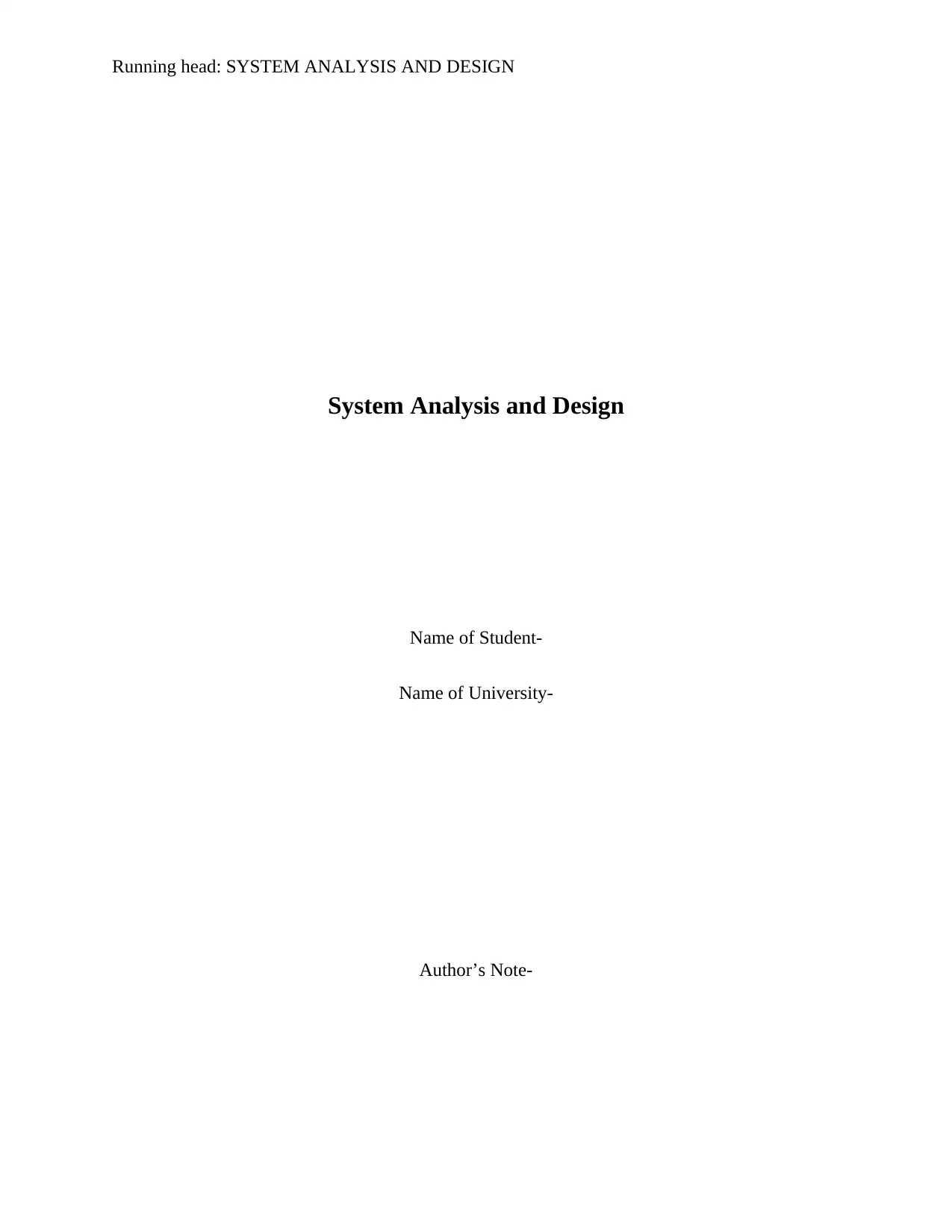
Running head: SYSTEM ANALYSIS AND DESIGN
System Analysis and Design
Name of Student-
Name of University-
Author’s Note-
System Analysis and Design
Name of Student-
Name of University-
Author’s Note-
Paraphrase This Document
Need a fresh take? Get an instant paraphrase of this document with our AI Paraphraser
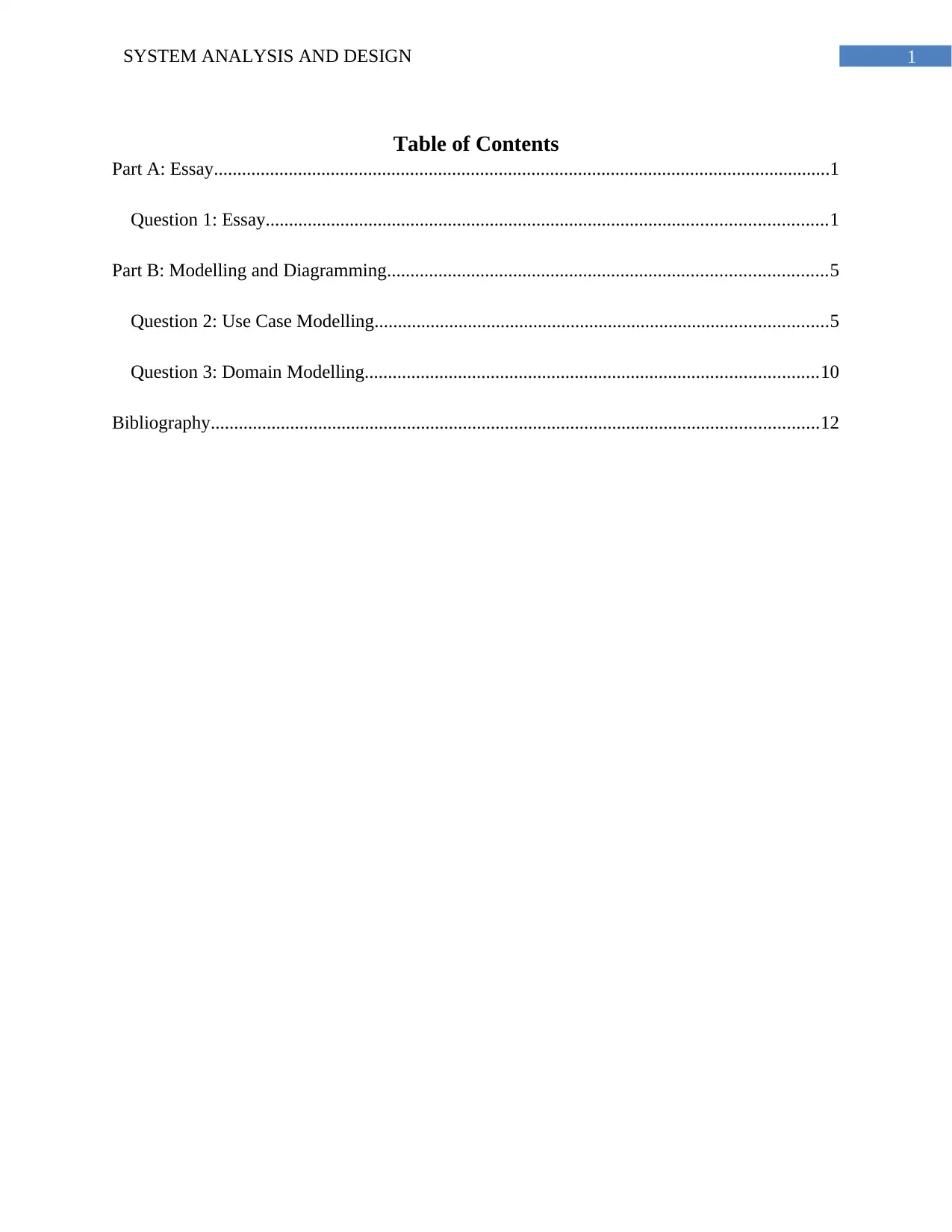
1SYSTEM ANALYSIS AND DESIGN
Table of Contents
Part A: Essay....................................................................................................................................1
Question 1: Essay........................................................................................................................1
Part B: Modelling and Diagramming..............................................................................................5
Question 2: Use Case Modelling.................................................................................................5
Question 3: Domain Modelling.................................................................................................10
Bibliography..................................................................................................................................12
Table of Contents
Part A: Essay....................................................................................................................................1
Question 1: Essay........................................................................................................................1
Part B: Modelling and Diagramming..............................................................................................5
Question 2: Use Case Modelling.................................................................................................5
Question 3: Domain Modelling.................................................................................................10
Bibliography..................................................................................................................................12
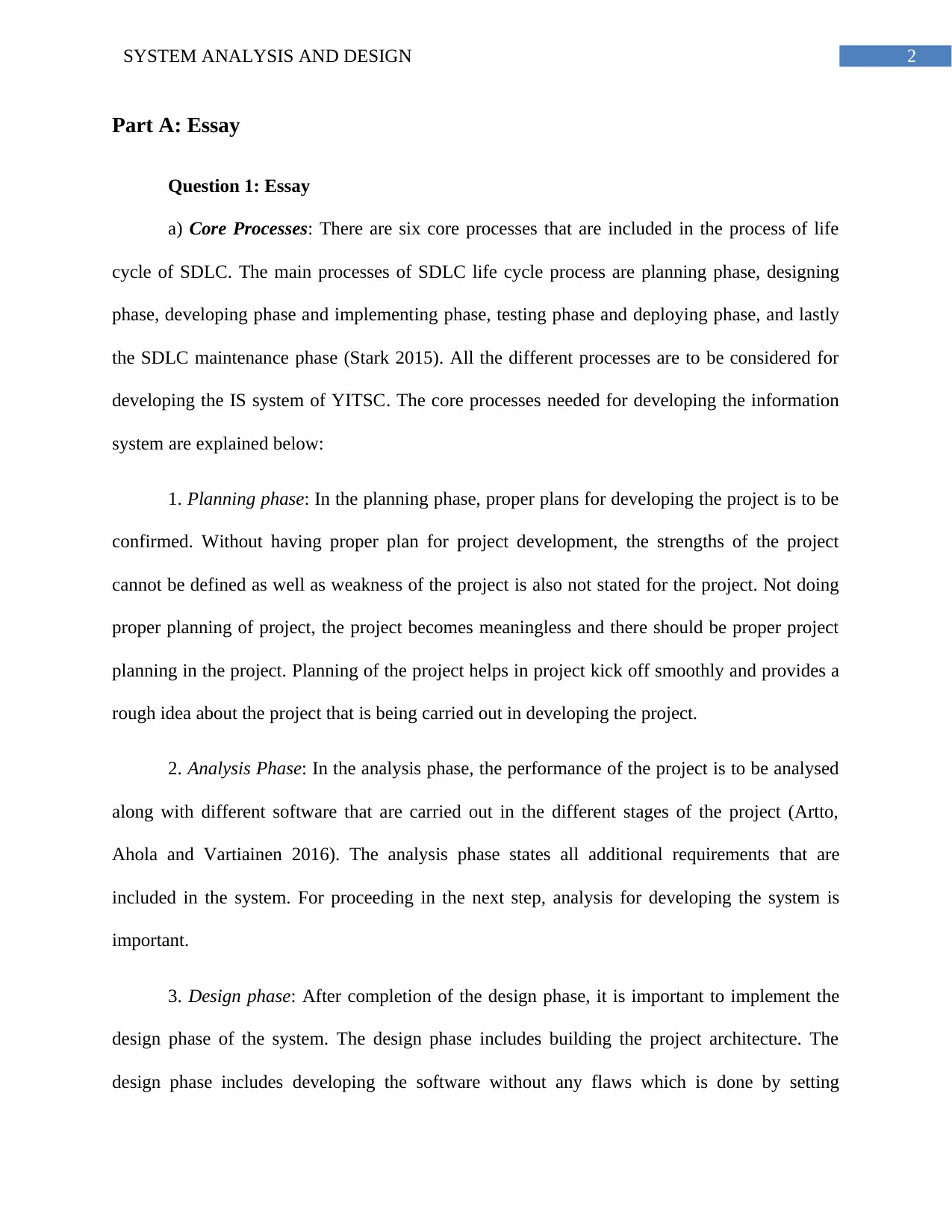
2SYSTEM ANALYSIS AND DESIGN
Part A: Essay
Question 1: Essay
a) Core Processes: There are six core processes that are included in the process of life
cycle of SDLC. The main processes of SDLC life cycle process are planning phase, designing
phase, developing phase and implementing phase, testing phase and deploying phase, and lastly
the SDLC maintenance phase (Stark 2015). All the different processes are to be considered for
developing the IS system of YITSC. The core processes needed for developing the information
system are explained below:
1. Planning phase: In the planning phase, proper plans for developing the project is to be
confirmed. Without having proper plan for project development, the strengths of the project
cannot be defined as well as weakness of the project is also not stated for the project. Not doing
proper planning of project, the project becomes meaningless and there should be proper project
planning in the project. Planning of the project helps in project kick off smoothly and provides a
rough idea about the project that is being carried out in developing the project.
2. Analysis Phase: In the analysis phase, the performance of the project is to be analysed
along with different software that are carried out in the different stages of the project (Artto,
Ahola and Vartiainen 2016). The analysis phase states all additional requirements that are
included in the system. For proceeding in the next step, analysis for developing the system is
important.
3. Design phase: After completion of the design phase, it is important to implement the
design phase of the system. The design phase includes building the project architecture. The
design phase includes developing the software without any flaws which is done by setting
Part A: Essay
Question 1: Essay
a) Core Processes: There are six core processes that are included in the process of life
cycle of SDLC. The main processes of SDLC life cycle process are planning phase, designing
phase, developing phase and implementing phase, testing phase and deploying phase, and lastly
the SDLC maintenance phase (Stark 2015). All the different processes are to be considered for
developing the IS system of YITSC. The core processes needed for developing the information
system are explained below:
1. Planning phase: In the planning phase, proper plans for developing the project is to be
confirmed. Without having proper plan for project development, the strengths of the project
cannot be defined as well as weakness of the project is also not stated for the project. Not doing
proper planning of project, the project becomes meaningless and there should be proper project
planning in the project. Planning of the project helps in project kick off smoothly and provides a
rough idea about the project that is being carried out in developing the project.
2. Analysis Phase: In the analysis phase, the performance of the project is to be analysed
along with different software that are carried out in the different stages of the project (Artto,
Ahola and Vartiainen 2016). The analysis phase states all additional requirements that are
included in the system. For proceeding in the next step, analysis for developing the system is
important.
3. Design phase: After completion of the design phase, it is important to implement the
design phase of the system. The design phase includes building the project architecture. The
design phase includes developing the software without any flaws which is done by setting
⊘ This is a preview!⊘
Do you want full access?
Subscribe today to unlock all pages.

Trusted by 1+ million students worldwide
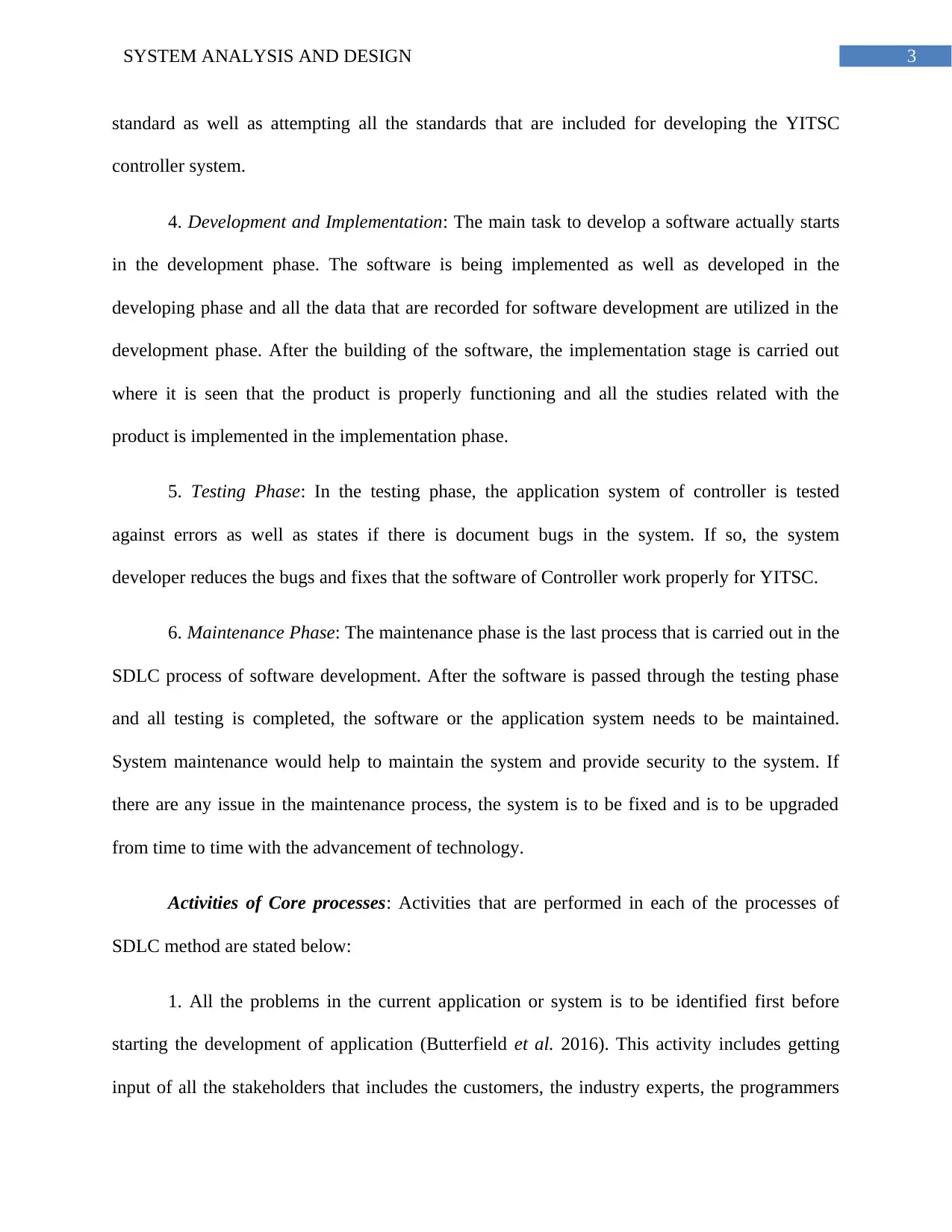
3SYSTEM ANALYSIS AND DESIGN
standard as well as attempting all the standards that are included for developing the YITSC
controller system.
4. Development and Implementation: The main task to develop a software actually starts
in the development phase. The software is being implemented as well as developed in the
developing phase and all the data that are recorded for software development are utilized in the
development phase. After the building of the software, the implementation stage is carried out
where it is seen that the product is properly functioning and all the studies related with the
product is implemented in the implementation phase.
5. Testing Phase: In the testing phase, the application system of controller is tested
against errors as well as states if there is document bugs in the system. If so, the system
developer reduces the bugs and fixes that the software of Controller work properly for YITSC.
6. Maintenance Phase: The maintenance phase is the last process that is carried out in the
SDLC process of software development. After the software is passed through the testing phase
and all testing is completed, the software or the application system needs to be maintained.
System maintenance would help to maintain the system and provide security to the system. If
there are any issue in the maintenance process, the system is to be fixed and is to be upgraded
from time to time with the advancement of technology.
Activities of Core processes: Activities that are performed in each of the processes of
SDLC method are stated below:
1. All the problems in the current application or system is to be identified first before
starting the development of application (Butterfield et al. 2016). This activity includes getting
input of all the stakeholders that includes the customers, the industry experts, the programmers
standard as well as attempting all the standards that are included for developing the YITSC
controller system.
4. Development and Implementation: The main task to develop a software actually starts
in the development phase. The software is being implemented as well as developed in the
developing phase and all the data that are recorded for software development are utilized in the
development phase. After the building of the software, the implementation stage is carried out
where it is seen that the product is properly functioning and all the studies related with the
product is implemented in the implementation phase.
5. Testing Phase: In the testing phase, the application system of controller is tested
against errors as well as states if there is document bugs in the system. If so, the system
developer reduces the bugs and fixes that the software of Controller work properly for YITSC.
6. Maintenance Phase: The maintenance phase is the last process that is carried out in the
SDLC process of software development. After the software is passed through the testing phase
and all testing is completed, the software or the application system needs to be maintained.
System maintenance would help to maintain the system and provide security to the system. If
there are any issue in the maintenance process, the system is to be fixed and is to be upgraded
from time to time with the advancement of technology.
Activities of Core processes: Activities that are performed in each of the processes of
SDLC method are stated below:
1. All the problems in the current application or system is to be identified first before
starting the development of application (Butterfield et al. 2016). This activity includes getting
input of all the stakeholders that includes the customers, the industry experts, the programmers
Paraphrase This Document
Need a fresh take? Get an instant paraphrase of this document with our AI Paraphraser
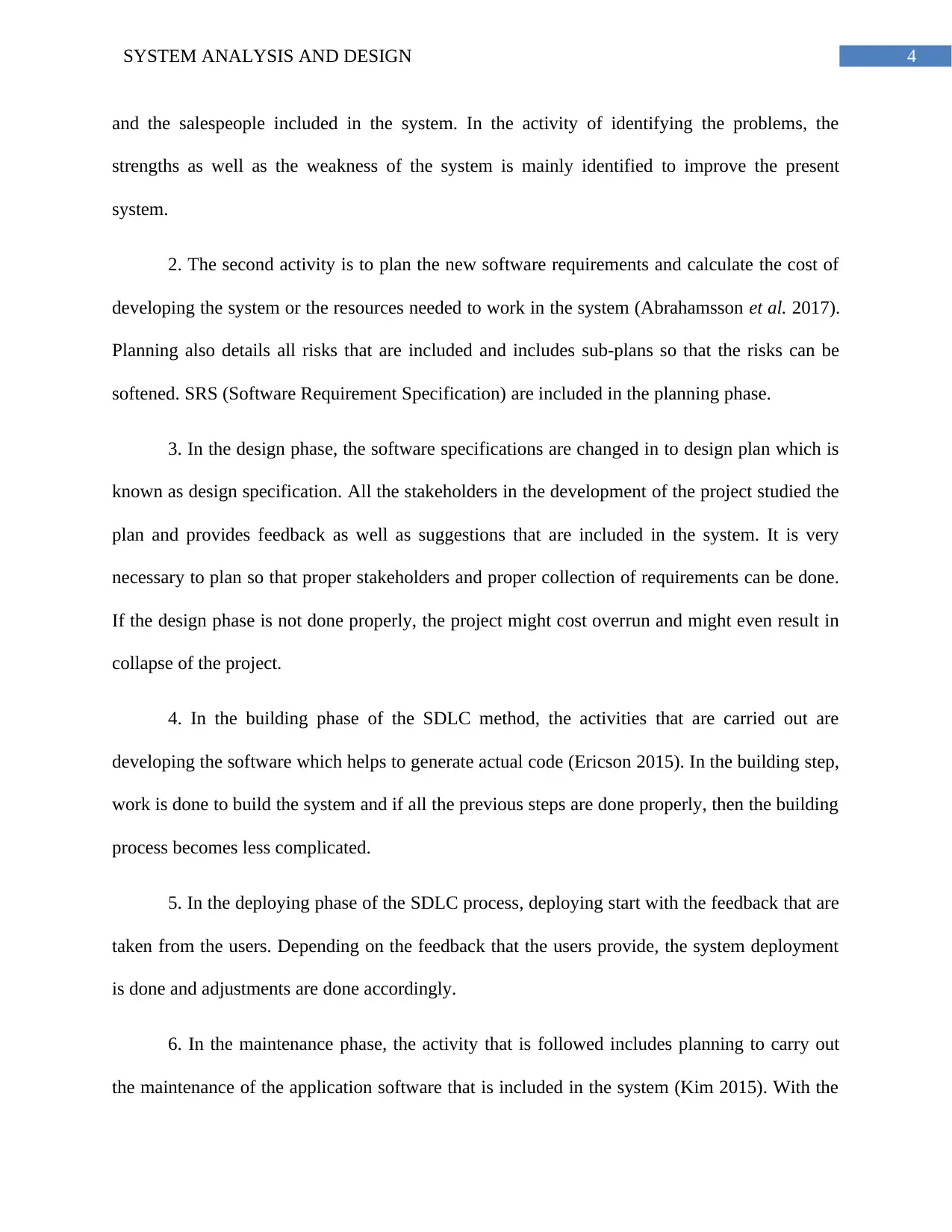
4SYSTEM ANALYSIS AND DESIGN
and the salespeople included in the system. In the activity of identifying the problems, the
strengths as well as the weakness of the system is mainly identified to improve the present
system.
2. The second activity is to plan the new software requirements and calculate the cost of
developing the system or the resources needed to work in the system (Abrahamsson et al. 2017).
Planning also details all risks that are included and includes sub-plans so that the risks can be
softened. SRS (Software Requirement Specification) are included in the planning phase.
3. In the design phase, the software specifications are changed in to design plan which is
known as design specification. All the stakeholders in the development of the project studied the
plan and provides feedback as well as suggestions that are included in the system. It is very
necessary to plan so that proper stakeholders and proper collection of requirements can be done.
If the design phase is not done properly, the project might cost overrun and might even result in
collapse of the project.
4. In the building phase of the SDLC method, the activities that are carried out are
developing the software which helps to generate actual code (Ericson 2015). In the building step,
work is done to build the system and if all the previous steps are done properly, then the building
process becomes less complicated.
5. In the deploying phase of the SDLC process, deploying start with the feedback that are
taken from the users. Depending on the feedback that the users provide, the system deployment
is done and adjustments are done accordingly.
6. In the maintenance phase, the activity that is followed includes planning to carry out
the maintenance of the application software that is included in the system (Kim 2015). With the
and the salespeople included in the system. In the activity of identifying the problems, the
strengths as well as the weakness of the system is mainly identified to improve the present
system.
2. The second activity is to plan the new software requirements and calculate the cost of
developing the system or the resources needed to work in the system (Abrahamsson et al. 2017).
Planning also details all risks that are included and includes sub-plans so that the risks can be
softened. SRS (Software Requirement Specification) are included in the planning phase.
3. In the design phase, the software specifications are changed in to design plan which is
known as design specification. All the stakeholders in the development of the project studied the
plan and provides feedback as well as suggestions that are included in the system. It is very
necessary to plan so that proper stakeholders and proper collection of requirements can be done.
If the design phase is not done properly, the project might cost overrun and might even result in
collapse of the project.
4. In the building phase of the SDLC method, the activities that are carried out are
developing the software which helps to generate actual code (Ericson 2015). In the building step,
work is done to build the system and if all the previous steps are done properly, then the building
process becomes less complicated.
5. In the deploying phase of the SDLC process, deploying start with the feedback that are
taken from the users. Depending on the feedback that the users provide, the system deployment
is done and adjustments are done accordingly.
6. In the maintenance phase, the activity that is followed includes planning to carry out
the maintenance of the application software that is included in the system (Kim 2015). With the
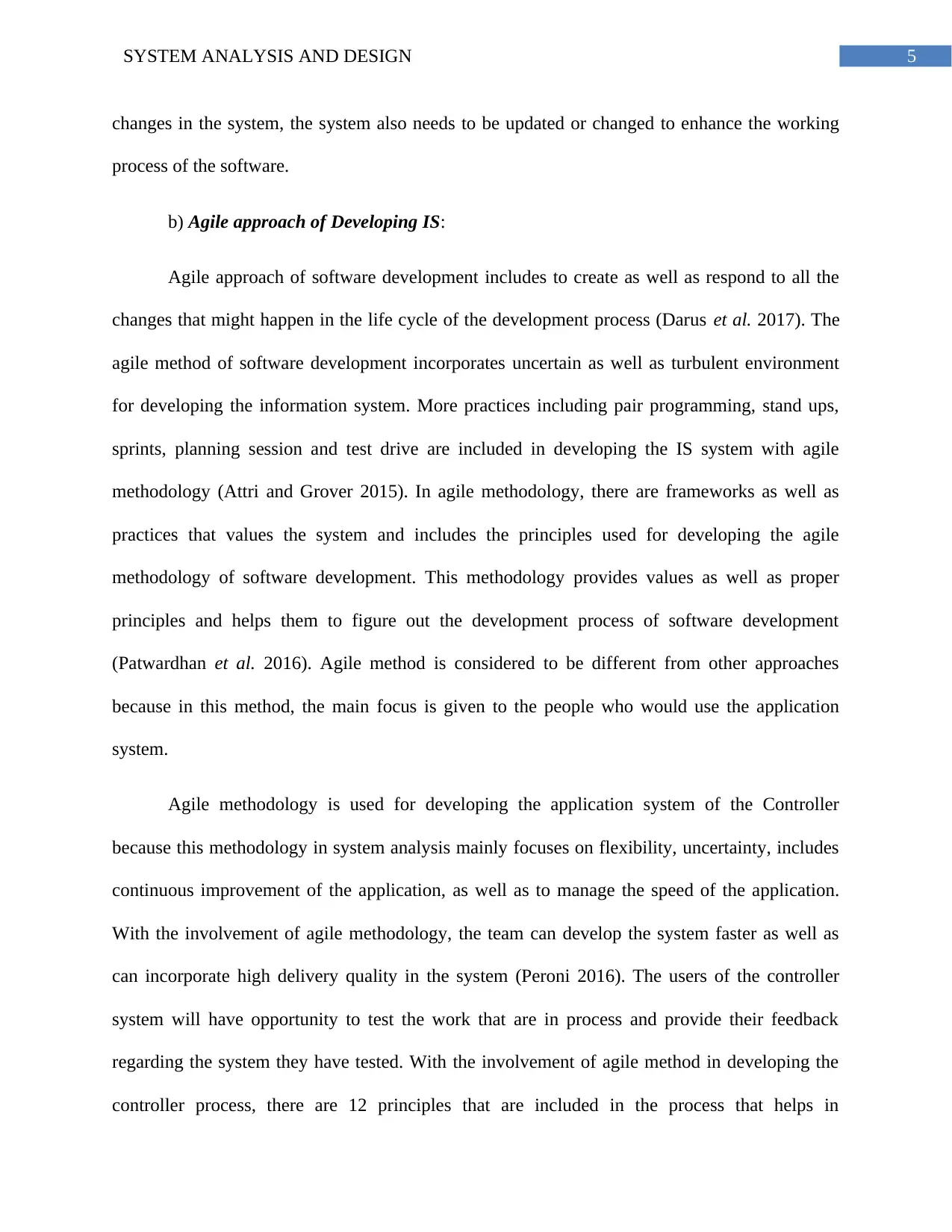
5SYSTEM ANALYSIS AND DESIGN
changes in the system, the system also needs to be updated or changed to enhance the working
process of the software.
b) Agile approach of Developing IS:
Agile approach of software development includes to create as well as respond to all the
changes that might happen in the life cycle of the development process (Darus et al. 2017). The
agile method of software development incorporates uncertain as well as turbulent environment
for developing the information system. More practices including pair programming, stand ups,
sprints, planning session and test drive are included in developing the IS system with agile
methodology (Attri and Grover 2015). In agile methodology, there are frameworks as well as
practices that values the system and includes the principles used for developing the agile
methodology of software development. This methodology provides values as well as proper
principles and helps them to figure out the development process of software development
(Patwardhan et al. 2016). Agile method is considered to be different from other approaches
because in this method, the main focus is given to the people who would use the application
system.
Agile methodology is used for developing the application system of the Controller
because this methodology in system analysis mainly focuses on flexibility, uncertainty, includes
continuous improvement of the application, as well as to manage the speed of the application.
With the involvement of agile methodology, the team can develop the system faster as well as
can incorporate high delivery quality in the system (Peroni 2016). The users of the controller
system will have opportunity to test the work that are in process and provide their feedback
regarding the system they have tested. With the involvement of agile method in developing the
controller process, there are 12 principles that are included in the process that helps in
changes in the system, the system also needs to be updated or changed to enhance the working
process of the software.
b) Agile approach of Developing IS:
Agile approach of software development includes to create as well as respond to all the
changes that might happen in the life cycle of the development process (Darus et al. 2017). The
agile method of software development incorporates uncertain as well as turbulent environment
for developing the information system. More practices including pair programming, stand ups,
sprints, planning session and test drive are included in developing the IS system with agile
methodology (Attri and Grover 2015). In agile methodology, there are frameworks as well as
practices that values the system and includes the principles used for developing the agile
methodology of software development. This methodology provides values as well as proper
principles and helps them to figure out the development process of software development
(Patwardhan et al. 2016). Agile method is considered to be different from other approaches
because in this method, the main focus is given to the people who would use the application
system.
Agile methodology is used for developing the application system of the Controller
because this methodology in system analysis mainly focuses on flexibility, uncertainty, includes
continuous improvement of the application, as well as to manage the speed of the application.
With the involvement of agile methodology, the team can develop the system faster as well as
can incorporate high delivery quality in the system (Peroni 2016). The users of the controller
system will have opportunity to test the work that are in process and provide their feedback
regarding the system they have tested. With the involvement of agile method in developing the
controller process, there are 12 principles that are included in the process that helps in
⊘ This is a preview!⊘
Do you want full access?
Subscribe today to unlock all pages.

Trusted by 1+ million students worldwide
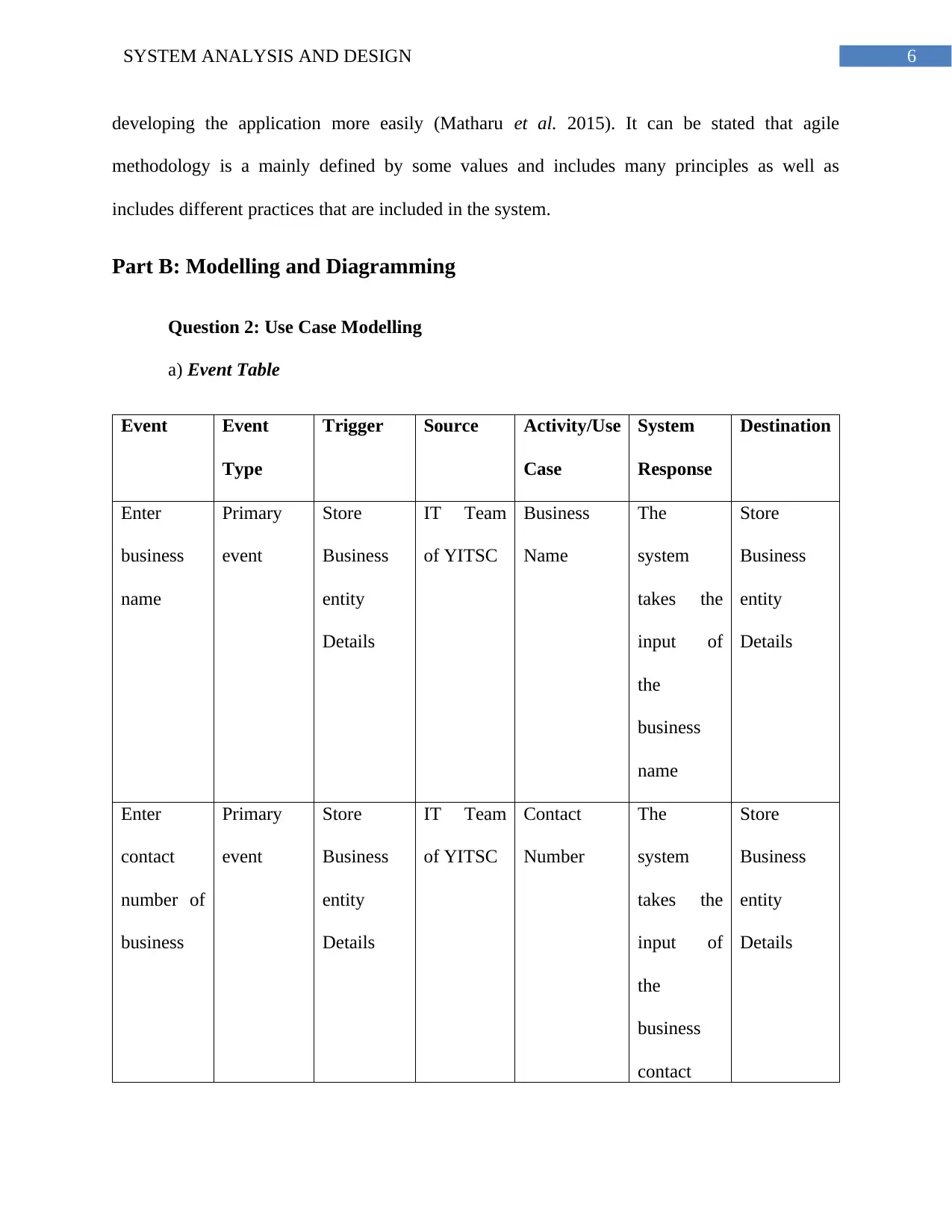
6SYSTEM ANALYSIS AND DESIGN
developing the application more easily (Matharu et al. 2015). It can be stated that agile
methodology is a mainly defined by some values and includes many principles as well as
includes different practices that are included in the system.
Part B: Modelling and Diagramming
Question 2: Use Case Modelling
a) Event Table
Event Event
Type
Trigger Source Activity/Use
Case
System
Response
Destination
Enter
business
name
Primary
event
Store
Business
entity
Details
IT Team
of YITSC
Business
Name
The
system
takes the
input of
the
business
name
Store
Business
entity
Details
Enter
contact
number of
business
Primary
event
Store
Business
entity
Details
IT Team
of YITSC
Contact
Number
The
system
takes the
input of
the
business
contact
Store
Business
entity
Details
developing the application more easily (Matharu et al. 2015). It can be stated that agile
methodology is a mainly defined by some values and includes many principles as well as
includes different practices that are included in the system.
Part B: Modelling and Diagramming
Question 2: Use Case Modelling
a) Event Table
Event Event
Type
Trigger Source Activity/Use
Case
System
Response
Destination
Enter
business
name
Primary
event
Store
Business
entity
Details
IT Team
of YITSC
Business
Name
The
system
takes the
input of
the
business
name
Store
Business
entity
Details
Enter
contact
number of
business
Primary
event
Store
Business
entity
Details
IT Team
of YITSC
Contact
Number
The
system
takes the
input of
the
business
contact
Store
Business
entity
Details
Paraphrase This Document
Need a fresh take? Get an instant paraphrase of this document with our AI Paraphraser
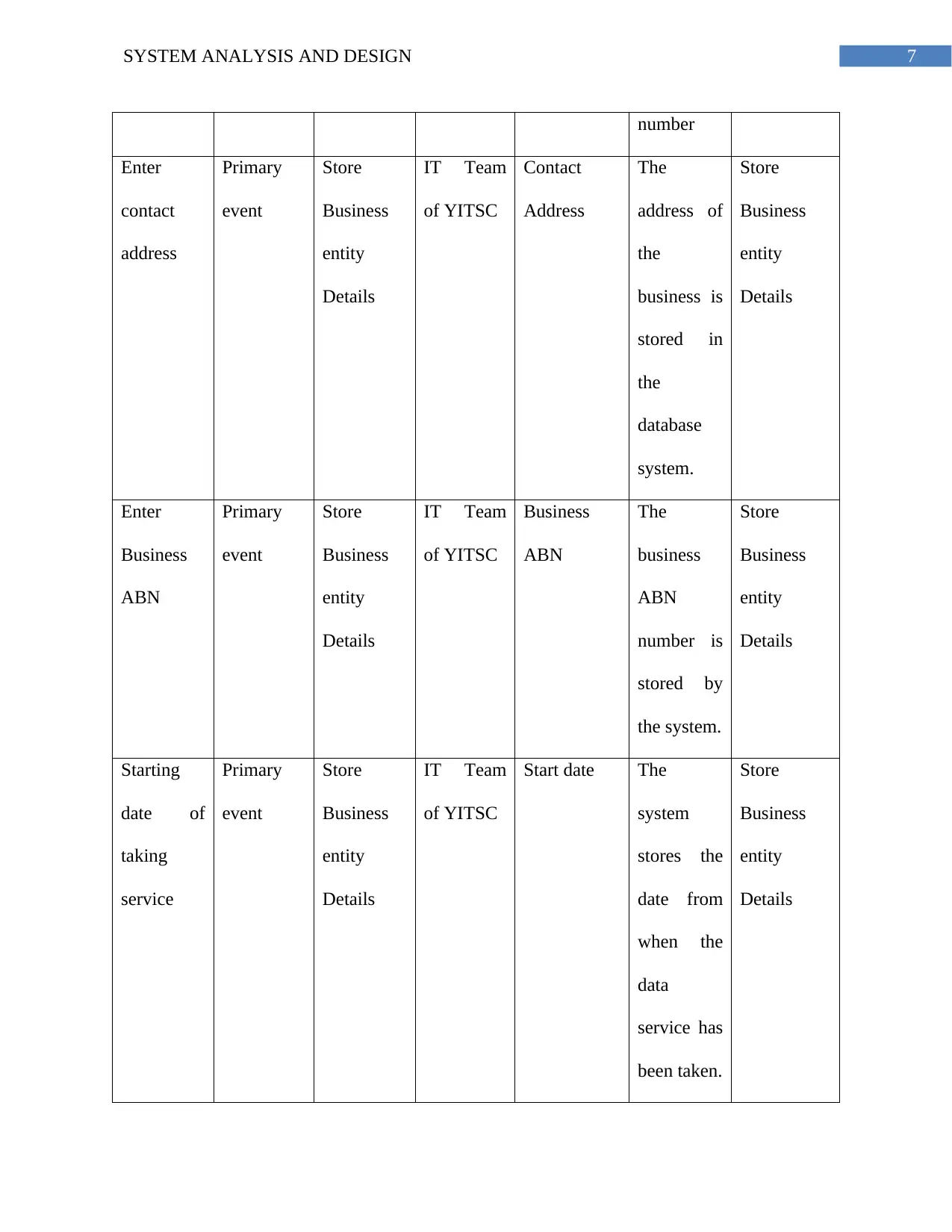
7SYSTEM ANALYSIS AND DESIGN
number
Enter
contact
address
Primary
event
Store
Business
entity
Details
IT Team
of YITSC
Contact
Address
The
address of
the
business is
stored in
the
database
system.
Store
Business
entity
Details
Enter
Business
ABN
Primary
event
Store
Business
entity
Details
IT Team
of YITSC
Business
ABN
The
business
ABN
number is
stored by
the system.
Store
Business
entity
Details
Starting
date of
taking
service
Primary
event
Store
Business
entity
Details
IT Team
of YITSC
Start date The
system
stores the
date from
when the
data
service has
been taken.
Store
Business
entity
Details
number
Enter
contact
address
Primary
event
Store
Business
entity
Details
IT Team
of YITSC
Contact
Address
The
address of
the
business is
stored in
the
database
system.
Store
Business
entity
Details
Enter
Business
ABN
Primary
event
Store
Business
entity
Details
IT Team
of YITSC
Business
ABN
The
business
ABN
number is
stored by
the system.
Store
Business
entity
Details
Starting
date of
taking
service
Primary
event
Store
Business
entity
Details
IT Team
of YITSC
Start date The
system
stores the
date from
when the
data
service has
been taken.
Store
Business
entity
Details

8SYSTEM ANALYSIS AND DESIGN
⊘ This is a preview!⊘
Do you want full access?
Subscribe today to unlock all pages.

Trusted by 1+ million students worldwide
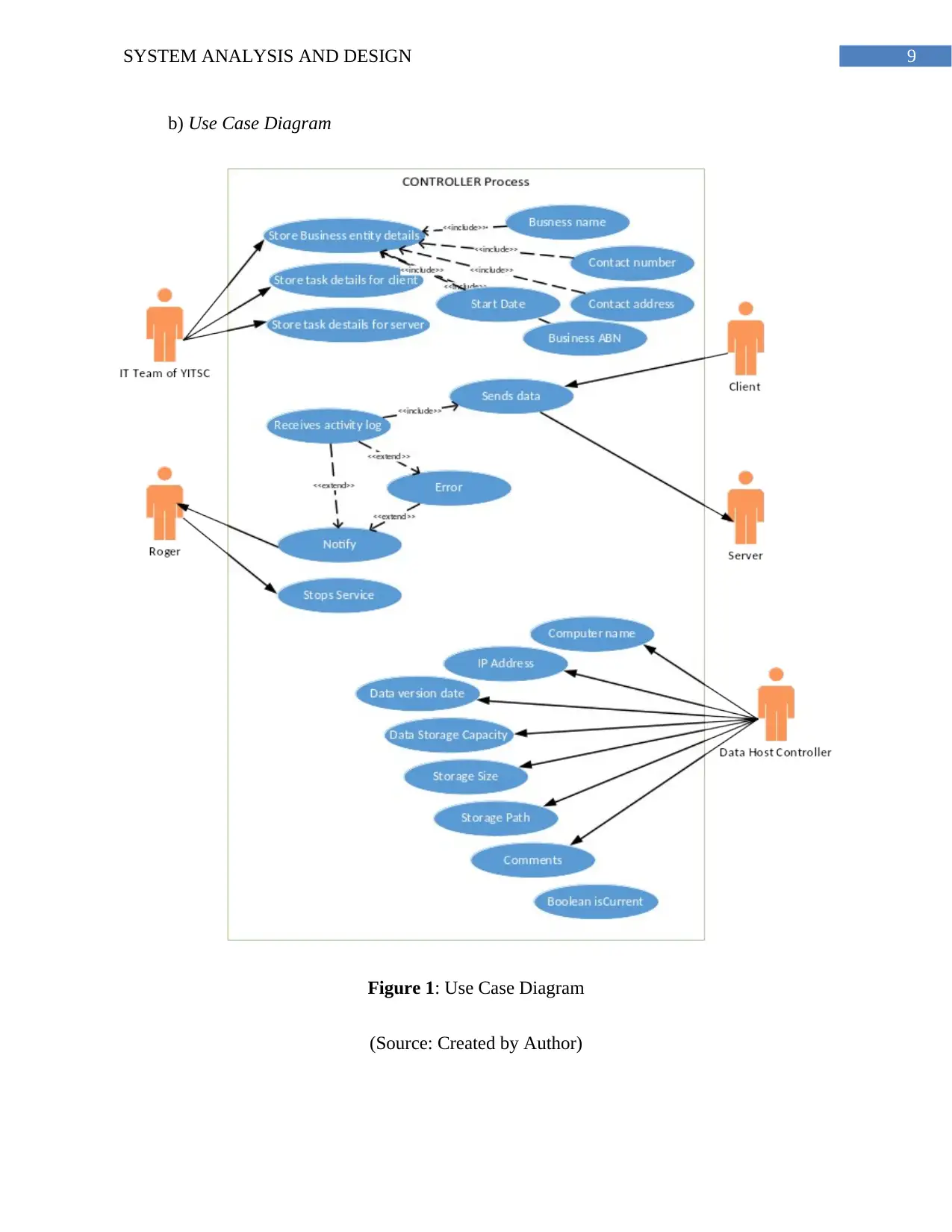
9SYSTEM ANALYSIS AND DESIGN
b) Use Case Diagram
Figure 1: Use Case Diagram
(Source: Created by Author)
b) Use Case Diagram
Figure 1: Use Case Diagram
(Source: Created by Author)
Paraphrase This Document
Need a fresh take? Get an instant paraphrase of this document with our AI Paraphraser
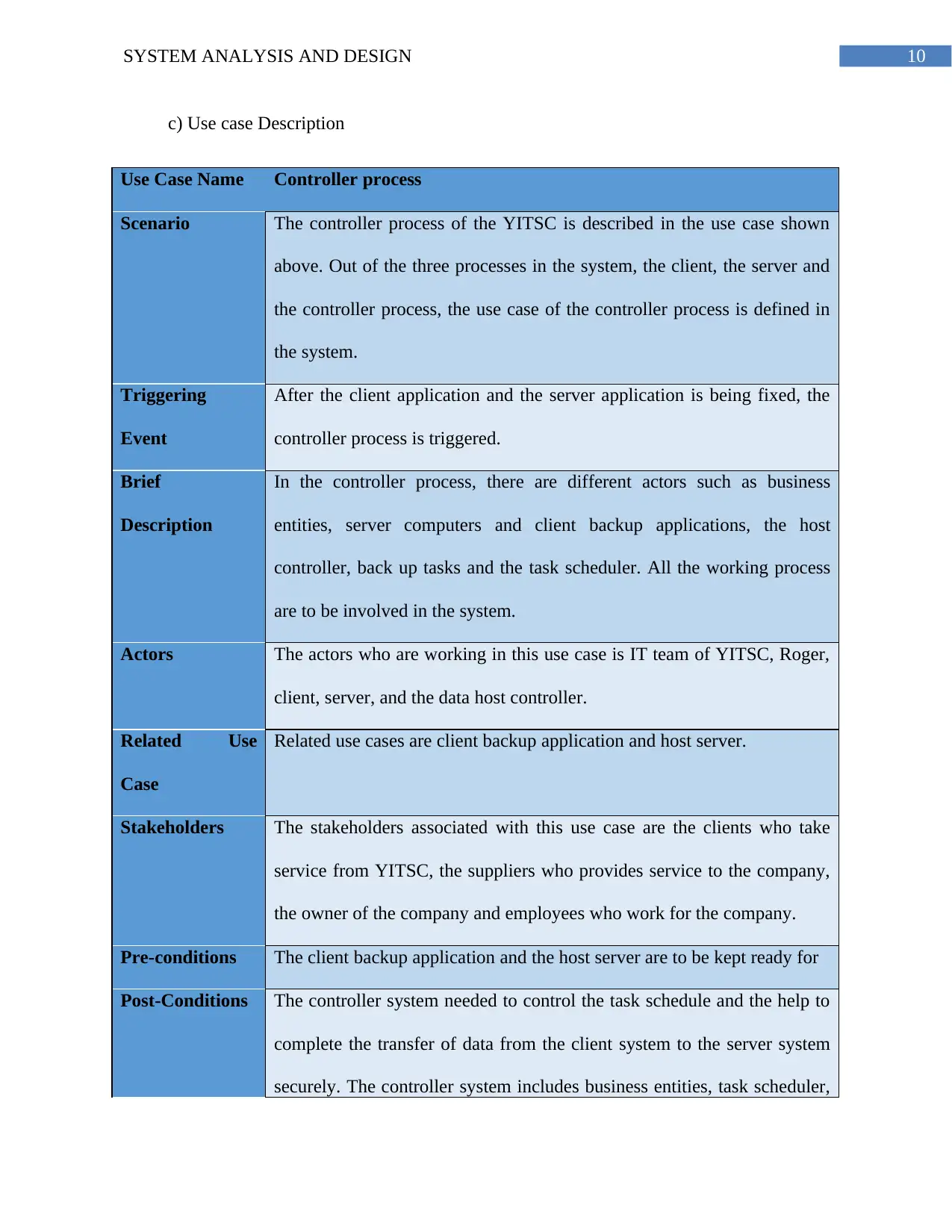
10SYSTEM ANALYSIS AND DESIGN
c) Use case Description
Use Case Name Controller process
Scenario The controller process of the YITSC is described in the use case shown
above. Out of the three processes in the system, the client, the server and
the controller process, the use case of the controller process is defined in
the system.
Triggering
Event
After the client application and the server application is being fixed, the
controller process is triggered.
Brief
Description
In the controller process, there are different actors such as business
entities, server computers and client backup applications, the host
controller, back up tasks and the task scheduler. All the working process
are to be involved in the system.
Actors The actors who are working in this use case is IT team of YITSC, Roger,
client, server, and the data host controller.
Related Use
Case
Related use cases are client backup application and host server.
Stakeholders The stakeholders associated with this use case are the clients who take
service from YITSC, the suppliers who provides service to the company,
the owner of the company and employees who work for the company.
Pre-conditions The client backup application and the host server are to be kept ready for
Post-Conditions The controller system needed to control the task schedule and the help to
complete the transfer of data from the client system to the server system
securely. The controller system includes business entities, task scheduler,
c) Use case Description
Use Case Name Controller process
Scenario The controller process of the YITSC is described in the use case shown
above. Out of the three processes in the system, the client, the server and
the controller process, the use case of the controller process is defined in
the system.
Triggering
Event
After the client application and the server application is being fixed, the
controller process is triggered.
Brief
Description
In the controller process, there are different actors such as business
entities, server computers and client backup applications, the host
controller, back up tasks and the task scheduler. All the working process
are to be involved in the system.
Actors The actors who are working in this use case is IT team of YITSC, Roger,
client, server, and the data host controller.
Related Use
Case
Related use cases are client backup application and host server.
Stakeholders The stakeholders associated with this use case are the clients who take
service from YITSC, the suppliers who provides service to the company,
the owner of the company and employees who work for the company.
Pre-conditions The client backup application and the host server are to be kept ready for
Post-Conditions The controller system needed to control the task schedule and the help to
complete the transfer of data from the client system to the server system
securely. The controller system includes business entities, task scheduler,
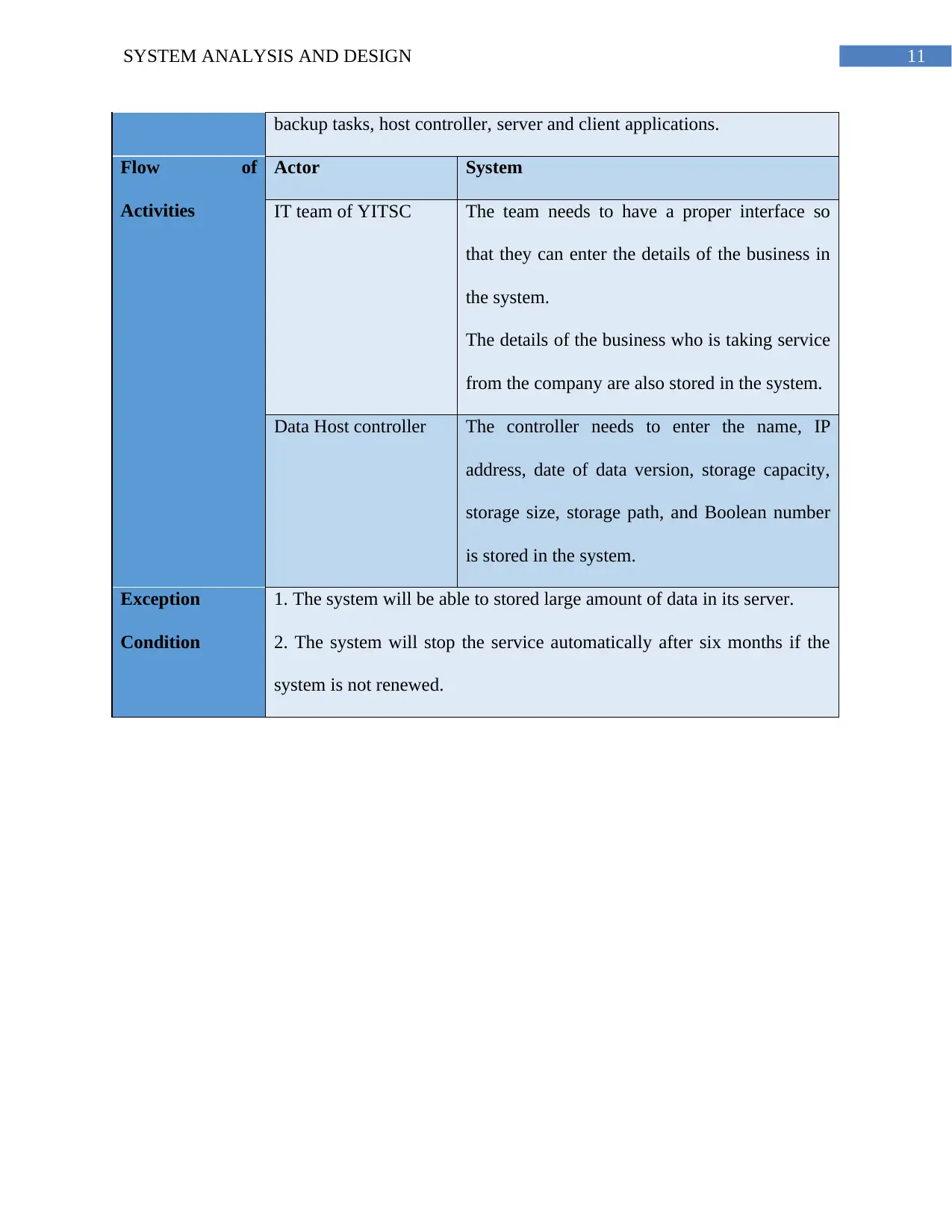
11SYSTEM ANALYSIS AND DESIGN
backup tasks, host controller, server and client applications.
Flow of
Activities
Actor System
IT team of YITSC The team needs to have a proper interface so
that they can enter the details of the business in
the system.
The details of the business who is taking service
from the company are also stored in the system.
Data Host controller The controller needs to enter the name, IP
address, date of data version, storage capacity,
storage size, storage path, and Boolean number
is stored in the system.
Exception
Condition
1. The system will be able to stored large amount of data in its server.
2. The system will stop the service automatically after six months if the
system is not renewed.
backup tasks, host controller, server and client applications.
Flow of
Activities
Actor System
IT team of YITSC The team needs to have a proper interface so
that they can enter the details of the business in
the system.
The details of the business who is taking service
from the company are also stored in the system.
Data Host controller The controller needs to enter the name, IP
address, date of data version, storage capacity,
storage size, storage path, and Boolean number
is stored in the system.
Exception
Condition
1. The system will be able to stored large amount of data in its server.
2. The system will stop the service automatically after six months if the
system is not renewed.
⊘ This is a preview!⊘
Do you want full access?
Subscribe today to unlock all pages.

Trusted by 1+ million students worldwide
1 out of 16
Related Documents
Your All-in-One AI-Powered Toolkit for Academic Success.
+13062052269
info@desklib.com
Available 24*7 on WhatsApp / Email
![[object Object]](/_next/static/media/star-bottom.7253800d.svg)
Unlock your academic potential
Copyright © 2020–2025 A2Z Services. All Rights Reserved. Developed and managed by ZUCOL.





